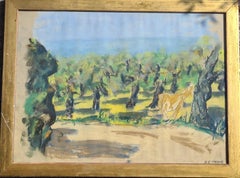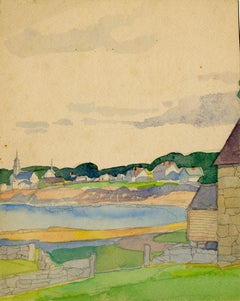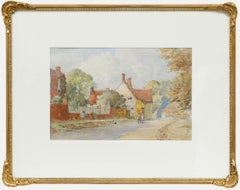Early 20th Century Landscape Drawings and Watercolors
Realist Early 20th Century Landscape Drawings and Watercolors
Paper, Watercolor
Impressionist Early 20th Century Landscape Drawings and Watercolors
Paper, Watercolor
Early 20th Century Landscape Drawings and Watercolors
Paper, Crayon, Watercolor
American Modern Early 20th Century Landscape Drawings and Watercolors
Watercolor, Pencil
Romantic Early 20th Century Landscape Drawings and Watercolors
Gouache
Early 20th Century Landscape Drawings and Watercolors
Watercolor
Realist Early 20th Century Landscape Drawings and Watercolors
Paper, Charcoal
American Impressionist Early 20th Century Landscape Drawings and Watercolors
Watercolor
Post-Impressionist Early 20th Century Landscape Drawings and Watercolors
Pastel
Impressionist Early 20th Century Landscape Drawings and Watercolors
Paper, Charcoal, Pastel
Art Nouveau Early 20th Century Landscape Drawings and Watercolors
Paper, Pencil
Impressionist Early 20th Century Landscape Drawings and Watercolors
Watercolor
Impressionist Early 20th Century Landscape Drawings and Watercolors
Paper, Watercolor
Victorian Early 20th Century Landscape Drawings and Watercolors
Paper, Watercolor
Impressionist Early 20th Century Landscape Drawings and Watercolors
Watercolor
Art Nouveau Early 20th Century Landscape Drawings and Watercolors
Paper, Pencil, India Ink
Early 20th Century Landscape Drawings and Watercolors
Watercolor
Post-Impressionist Early 20th Century Landscape Drawings and Watercolors
Paper, Ink
American Impressionist Early 20th Century Landscape Drawings and Watercolors
Paper, Watercolor
Victorian Early 20th Century Landscape Drawings and Watercolors
Paper, Watercolor
Early 20th Century Landscape Drawings and Watercolors
Watercolor
Early 20th Century Landscape Drawings and Watercolors
Watercolor
Tonalist Early 20th Century Landscape Drawings and Watercolors
Pastel
Early 20th Century Landscape Drawings and Watercolors
Watercolor, Gouache
Art Deco Early 20th Century Landscape Drawings and Watercolors
Pastel, Watercolor
Early 20th Century Landscape Drawings and Watercolors
Watercolor
Impressionist Early 20th Century Landscape Drawings and Watercolors
Paper, Watercolor, Gouache, Board
Impressionist Early 20th Century Landscape Drawings and Watercolors
Paper, Ink, Watercolor
Early 20th Century Landscape Drawings and Watercolors
Paper, Watercolor
Modern Early 20th Century Landscape Drawings and Watercolors
Watercolor, Pencil
American Modern Early 20th Century Landscape Drawings and Watercolors
Watercolor, Laid Paper
Impressionist Early 20th Century Landscape Drawings and Watercolors
Ink, Paper, Watercolor
Post-Impressionist Early 20th Century Landscape Drawings and Watercolors
Watercolor, Illustration Board
Modern Early 20th Century Landscape Drawings and Watercolors
Gouache
Impressionist Early 20th Century Landscape Drawings and Watercolors
Ink, Paper, Watercolor
Impressionist Early 20th Century Landscape Drawings and Watercolors
Ink, Watercolor, Paper
Expressionist Early 20th Century Landscape Drawings and Watercolors
Charcoal
Pre-Raphaelite Early 20th Century Landscape Drawings and Watercolors
Watercolor, Paper, Pencil
Naturalistic Early 20th Century Landscape Drawings and Watercolors
Watercolor, Laid Paper
Early 20th Century Landscape Drawings and Watercolors
Watercolor
Land Early 20th Century Landscape Drawings and Watercolors
Paper, Watercolor, Ink
Modern Early 20th Century Landscape Drawings and Watercolors
Graphite
Modern Early 20th Century Landscape Drawings and Watercolors
Paper, Watercolor
Modern Early 20th Century Landscape Drawings and Watercolors
Color Pencil
Impressionist Early 20th Century Landscape Drawings and Watercolors
Gouache
Early 20th Century Landscape Drawings and Watercolors
Watercolor, Paper
American Impressionist Early 20th Century Landscape Drawings and Watercolors
Watercolor
Early 20th Century Landscape Drawings and Watercolors
Canvas, Pastel, Laid Paper
Post-Impressionist Early 20th Century Landscape Drawings and Watercolors
Pastel
Victorian Early 20th Century Landscape Drawings and Watercolors
Paper, Watercolor
Early 20th Century Landscape Drawings and Watercolors
Watercolor
Realist Early 20th Century Landscape Drawings and Watercolors
Watercolor
Early 20th Century Landscape Drawings and Watercolors
Watercolor
Impressionist Early 20th Century Landscape Drawings and Watercolors
Watercolor, Gouache, Paper
Romantic Early 20th Century Landscape Drawings and Watercolors
Watercolor
Cubist Early 20th Century Landscape Drawings and Watercolors
Ink
American Modern Early 20th Century Landscape Drawings and Watercolors
Watercolor
Impressionist Early 20th Century Landscape Drawings and Watercolors
Paper, Watercolor, Gouache, Pencil
Early 20th Century Landscape Drawings and Watercolors
Watercolor
French School Early 20th Century Landscape Drawings and Watercolors
Paper, Oil, Watercolor, Board, Pencil




